[an error occurred while processing this directive]
Herb Lore
by Lois June Wickstrom
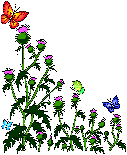
I’ll start with the standard warning: This page reflects only my own
experiments using herbs on myself, family and friends. It is not an official medical study
-- the sample size isn’t large enough and I used no controls. Because the only
experimental subjects have been eager participants, you should also count psychological
factors into the success of these experiments. My favorite herbal reference books are The
Herb Book by John Lust and Menopausal Years by Susun Weed. I also use David L.
Hoffman’s CD-ROM The Herbalist. Now that you know I’m not an authority,
here’s what I’ve found:
To Brew Tea from Herbs
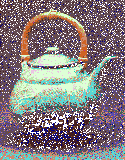 Some herbs are stronger than tasting than others,
and some batches of the same herb are more powerful than others, so you will have to
experiment. As a general guideline, put 1 Tbsp dried herb (cut and
sifted) or 4 Tbsp fresh herb into a teapot. Add 1 quart
boiling or very hot water. Let steep for 20 minutes. This is long enough to extract the medicinal properties of the herbs and
long enough to let the tea cool-off enough to drink. Some herbs are stronger than tasting than others,
and some batches of the same herb are more powerful than others, so you will have to
experiment. As a general guideline, put 1 Tbsp dried herb (cut and
sifted) or 4 Tbsp fresh herb into a teapot. Add 1 quart
boiling or very hot water. Let steep for 20 minutes. This is long enough to extract the medicinal properties of the herbs and
long enough to let the tea cool-off enough to drink.
Growing Herbs Most herbs are weeds. You may already have them in your yard. And once you
do plant herbs, most will come back year after year, either by sending up new shoots, or
by reseeding themselves. Many will spread uncontrollably -- soon you'll be able to give
mint, raspberries, comfrey and other spreaders to your neighbors. Most herbs don't require
the same high quality soil that vegetables demand. I throw my old steel cans into my
raspberry patch because the rust keeps down the bindweed. Most herbs don't require much
care. Be sure to cut down dead or diseased canes in the raspberry patch. Cut off the
flowers on the basil if you want to prolong the leafing season. My mother has kept a basil
plant alive and leafing for over a year by cutting off every flower before it can go to
seed. In my experience, herbs require very little care. You can pick up to 10% of the
leaves off a plant without harming it. Raspberry leaves continue to taste good after
frost, but basil doesn't. Some herbs will simply refuse to grow in your yard. Angelica
won't even sprout for me in potting soil, but alpine strawberries do. Growing herbs is
much like herb medicine -- you have to experiment with what works for you.
The dis-eases people bring to me fit into four categories:
Menu
Mucous membrane dis-eases include colds, flu, vaginal and uterine infections,
thrush, sore throats, and eye infections
Golden Seal Root Powder
This is a very powerful herb. It tastes terrible (unless you have a bad cold). It promotes
healing throughout the body, anywhere there is a mucous membrane. If taken in overdose, it
can cause blisters in the mouth and on other mucous membranes. I recommend taking one 00
capsule three times a day, with meals, no more frequently than at 4 hour intervals. If you
have a beastly cold, you won’t taste it anyway, so you could put a 1/2 teaspoonful
into a teacup of hot water and drink it.
[Menu] [Index]
Fenugreek seeds
Brew like cut and sifted herb tea above. This tea helps clear stuffed sinus. It also
tastes good. You can also add a Tbsp of these seeds to 1 cup of rice before boiling -- I
even do that when I'm not sick because I like the flavor.
[Menu] [Index]
Garlic
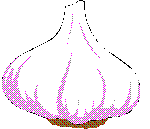 Eating this herb will help clear sinuses.
That’s why you feel better after eating spicy Asian foods when you have a cold. The cayenne
helps, too. You can eat it raw or cooked. You can slice it into pill-sized wedges and
swallow them with juice or tea as if they were pills. Garlic is also excellent for
clearing up itchy vaginal infections. Depending on how sore you are, you can peel one (be
sure not to nick it) and use it directly as a suppository, or you can wrap it in
cheese cloth to prevent direct contact with sore tissues. Or if the infection has just
gotten started and not done much tissue damage yet, you can put the garlic into a blender
with plain yogurt and blend until smooth. Then apply the garlic/yogurt mix with a baster
or spoon. A garlic suppository placed against the uterus will help fight uterine
infections. (This is the only thing that worked to clear up an IUD caused infection --
after prescribed medicines failed.) The garlic suppository works especially well in
combination with golden seal capsules taken by mouth. Eating this herb will help clear sinuses.
That’s why you feel better after eating spicy Asian foods when you have a cold. The cayenne
helps, too. You can eat it raw or cooked. You can slice it into pill-sized wedges and
swallow them with juice or tea as if they were pills. Garlic is also excellent for
clearing up itchy vaginal infections. Depending on how sore you are, you can peel one (be
sure not to nick it) and use it directly as a suppository, or you can wrap it in
cheese cloth to prevent direct contact with sore tissues. Or if the infection has just
gotten started and not done much tissue damage yet, you can put the garlic into a blender
with plain yogurt and blend until smooth. Then apply the garlic/yogurt mix with a baster
or spoon. A garlic suppository placed against the uterus will help fight uterine
infections. (This is the only thing that worked to clear up an IUD caused infection --
after prescribed medicines failed.) The garlic suppository works especially well in
combination with golden seal capsules taken by mouth.
[Menu] [Index]
Yogurt
Yogurt’s not an herb, but it belongs here as a folk remedy. Yogurt contains the same
bacteria as a normal vagina. You can use yogurt to increase the population of the good
bacteria and help them compete against the bad bacteria (bad here being defined as the
ones that make women sore and itchy). You can use a blender or egg beater to make the
yogurt smooth enough to apply to the walls of the vagina with a baster. Be sure to wear a
sanitary pad with this -- it will leak out and a tampon won’t work. (Note: when you
take penicillin or other antibiotic, the medicine kills your normal intestinal flora (many
of which are also the yogurt bacteria.) If you eat yogurt while you take penicillin, you
will have fewer digestive problems.)
[Menu] [Index]
Peppermint
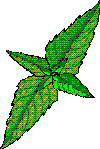 This herb can be added to any other tea. It tastes
good and it helps fight fever. It also helps many herbs, such as catnip and fenugreek, get
to work faster. I particularly recommend mixing it with raspberry leaves to reduce
menstrual flow and mitigate cramps. The only caution I have here is for those people who
have mint allergies. This herb can be added to any other tea. It tastes
good and it helps fight fever. It also helps many herbs, such as catnip and fenugreek, get
to work faster. I particularly recommend mixing it with raspberry leaves to reduce
menstrual flow and mitigate cramps. The only caution I have here is for those people who
have mint allergies.
[Menu] [Index]
Hyssop
This herb makes a pleasant tasting tea that helps clear sinuses.
[Menu] [Index]
Slippery Elm Bark
Tea made from this herb feels great on a sore throat and helps it heal.
[Menu] [Index]
Red Root or Jersey Tea
Tea from this herb doesn’t feel good right away on a sore throat, but it does help it
heal faster. You'll notice the results about 8 hours after you drink it.
[Menu] [Index]
Comfrey (root or leaves)
 Before using this tea, or any tea, for an eye
bath be sure to strain it through a folded handkerchief or several layers of paper towel.
If you are using a handkerchief, it is a good idea to boil or even pressure cook it before
pouring tea through it. Comfrey is soothing for inflamed eyes and conjunctivitis. The
easiest way I’ve found to apply herbs is to dip a washcloth in the strained herb and
lay the cloth over closed eyes, while you lie on your back. Enough of the tea will seep
into the eyes to be effective. Put a towel under your head to catch the drips. Before using this tea, or any tea, for an eye
bath be sure to strain it through a folded handkerchief or several layers of paper towel.
If you are using a handkerchief, it is a good idea to boil or even pressure cook it before
pouring tea through it. Comfrey is soothing for inflamed eyes and conjunctivitis. The
easiest way I’ve found to apply herbs is to dip a washcloth in the strained herb and
lay the cloth over closed eyes, while you lie on your back. Enough of the tea will seep
into the eyes to be effective. Put a towel under your head to catch the drips.
This herb also promotes skin growth on scrapes, cuts, burns and bruises. (It was great
when I got mugged. My hands were completely covered with skin again within a week -- I
also used aloe vera juice to draw the new skin together.) Do not let the leaves contact
any part of the body for any extended period of time -- the leaves promote skin growth,
and skin will grow right to the leaf in a matter of hours. (I know -- I did this after a
motorbike accident.)
[Menu] [Index]
Eyebright
Some people find this herb more effective than comfrey for relief of bloodshot eyes. Also,
there are some people who believe that the use of herbs to improve the eyes will also
improve clairvoyance.
[Menu] [Index]
Treatments of the female reproductive tract includes infertility, pregnancy,
menstrual distress, excessive uterine bleeding, and unpleasant menopausal symptoms
[Menu] [Index]
Red Rasberry Leaves
 Tea from this herb helps the uterus reabsorb,
rather than slough the monthly lining. Thus it reduces bleeding and cramping. It contains
calcium. Whenever muscle contracts or relaxes, it uses calcium. This herb is useful to
strengthen the uterus during pregnancy, to relieve the Braxton-Hicks contractions of late
pregnancy, and to make early labor more comfortable. Several American Indian tribes claim
that the use of this herb starting at the third month of pregnancy will give a short
labor. The flavor blends well with peppermint and catnip. Tea from this herb helps the uterus reabsorb,
rather than slough the monthly lining. Thus it reduces bleeding and cramping. It contains
calcium. Whenever muscle contracts or relaxes, it uses calcium. This herb is useful to
strengthen the uterus during pregnancy, to relieve the Braxton-Hicks contractions of late
pregnancy, and to make early labor more comfortable. Several American Indian tribes claim
that the use of this herb starting at the third month of pregnancy will give a short
labor. The flavor blends well with peppermint and catnip.
[Menu] [Index]
Chamomile Flowers
Tea from this herb will often start a late period if no pregnancy has occured. It is not
an abortifacient. It relieves menstrual cramps, but increases menstrual flow. It also
helps many women who have menstrual related insomnia. If you are going to drink this tea
during your menstrual period be sure to wear a maxipad even if you are wearing a tampon.
Some women react very powerfully to this herb.
[Menu] [Index]
Blue Cohosh Root
This is a multipurpose herb. Fair warning -- it is an abortifacient in the first
trimester. (It doesn’t always cause miscarriage, but enough books warn of this that
the warning must be passed on.) This herb is a powerful laxative, and it will work during
labor so you won’t have to endure an enema. It will start labor if the bag of water
has broken. This herb softens the cervix, so most books don’t recommend drinking the
tea during pregnancy unless you are trying to induce labor. It also shortens labor. The
tea tastes a bit like mud. Then again, I used it with my second pregnancy and had a
one-hour labor. (My first labor was only 3 and a half hours -- so I’m not a typical
example.)
[Menu] [Index]
False Unicorn Root (Helonius Root)
Everybody asks, so I’ll answer up front -- I’ve never seen a true unicorn
root. I’ve only had occasion to give this herb to three women. Two of them got
pregnant (which was what they wanted). This herb is the one the books recommend most often
for infertility. The books also recommend that both partners eat lots of raw wheat germ
sprinkled on all their meals. And they recommend that men who want to fatherchildren wear
boxer shorts to keep their testicles cool. Sperm swim best when they are 3° below body
temperature.
[Menu] [Index]
Shepard’s Purse Leaves
Tea brewed from this herb substantially reduces uterine bleeding, either during the
menstrual period or postpartum. It tastes good with a mixture of raspberry leaves and
peppermint leaves. It also relieves some of the discomfort of menopause. This tea can also
be applied to wounds to speed clotting and reduce external bleeding.
[Menu] [Index]
Nettles
Nettles are high in iron. Nettle tea simply makes periods more comfortable. Remember,
having a period is work. You can make it less work by eating correctly for your body, and
by taking herbs that benefit you. Still, don’t expect to feel like you do the rest of
the month. Kelp pills are also a good source of iron. Both kelp and nettles help during
menopause, too.
[Menu] [Index]
Burdock
This herb as a reputation as a male aphrodisiac. Obviously, I can’t try it on myself,
and none of the men I know are comfortable talking about whether it worked for them. So
I‘ll have to say that use is still speculative and experimental. More documented uses
include the secretory and extretory systems. It helps the liver and kidneys, which have
extra strain during pregnancy.
[Menu] [Index]
Addenda:
Comfrey will heal vaginal tearing or caesarian stitches. I used it to heal the stitches in
my belly button and pubic region after I got my tubes cut. Catnip will help take the edge
off the tension that goes with the hormonal changes that occur with the menstrual period,
pregnancy, and post parturition. Catnip tea (with a little cinnamon) is good for babies
who won’t sleep. So is vacuuming under their cribs or putting them on a running
dryer. Vitamin E and olive oil will sooth stretched skin. Do not eat sage or drink sage
tea when you are nursing. It will reduce the milk production. But if you are trying to dry
up, sage is great. Anise, basil, dill, fennel, hops, and parsley will increase milk
production. Nursing will cause cramps, but it reduces uterine bleeding. I recommend
drinking raspberry and peppermint leaf tea before or during nursing. Other herbs for
menopause are balm, rosemary, hops, chervil and lady’s mantle.
[Menu] [Index]
[Menu] [Index]
Yellow Dock Root
This herb is not normally used internally. It is a drawing herb. It will help draw
an infection to the surface and will stimulate blood flow to an infected area. This herb
tea is best used as hot as you can stand it, paired with ice water. The technique is to
alternate soaking the affected part alternately in the hot yellow dock tea and then in the
ice water. This can be done in tea cups or small bowls for small body parts like ear
lobes, fingers and toes. For larger parts, apply the hot tea and ice water with wash
cloths.
[Menu] [Index]
Aloe Vera
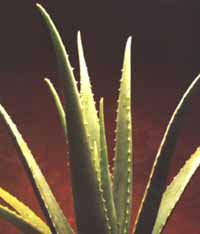 I don’t recommend internal use of this herb. The
useful part is the juice of the cactus-like leaf. You can have a plant, or buy the bottled
juice. The juice speeds healing of burns and bruises, and makes them more comfortable. If
you have a wound, it will help pull the edges of the skin together. Don’t worry --
your skin will still fit when you are healed. Apply the juice freely to the affected area.
(Note: fluoride toothpaste is also good to put on burns -- it stops the pain instantly and
speeds healing.) I don’t recommend internal use of this herb. The
useful part is the juice of the cactus-like leaf. You can have a plant, or buy the bottled
juice. The juice speeds healing of burns and bruises, and makes them more comfortable. If
you have a wound, it will help pull the edges of the skin together. Don’t worry --
your skin will still fit when you are healed. Apply the juice freely to the affected area.
(Note: fluoride toothpaste is also good to put on burns -- it stops the pain instantly and
speeds healing.)
[Menu] [Index]
Lobelia herb
This herb is not recommended for internal use -- it can cause vomiting. Externally
it’s great to relieve swelling and itching from bee stings. You can use either the
tea, or a warm oil extract. Put a few spoonfuls of salad oil in a small pan. Add a
spoonful of dried lobelia herb and heat until warm. The warm oil will feel soothing, and
it will stick to the bee sting better than tea. If you strain the oil, it can also be used
to relieve ear aches.
[Menu] [Index]
Onion
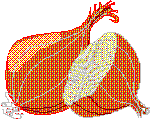 Onion is good to lower blood pressure, and
reduce fever. But a little known use is treatment of ear aches. Steam an onion. Cut it in
half. As soon as it is cool enough to handle, place the steamy onion against an achy ear.
It stimulates blood circulation to the area and brings relief. Onion is good to lower blood pressure, and
reduce fever. But a little known use is treatment of ear aches. Steam an onion. Cut it in
half. As soon as it is cool enough to handle, place the steamy onion against an achy ear.
It stimulates blood circulation to the area and brings relief.
[Menu] [Index]
Lemon
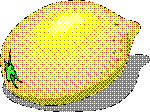 The active form of this herb is the fresh squeezed
juice. You can use bottled juice if necessary. Often an ear aches because the eustachian
tube is blocked with mucous. Drinking even a few spoonfuls of lemon juice will often
unblock the eustachian tubes and let the ear drain, thus relieving the pressure that
caused the pain. Use this herb sparingly because in quantity, it can damage tooth enamel.
Lemon juice is also useful to stop itching hemorrhoids and help them shrink. (Warning --
it can sting when first applied, but it’s worth it.) The active form of this herb is the fresh squeezed
juice. You can use bottled juice if necessary. Often an ear aches because the eustachian
tube is blocked with mucous. Drinking even a few spoonfuls of lemon juice will often
unblock the eustachian tubes and let the ear drain, thus relieving the pressure that
caused the pain. Use this herb sparingly because in quantity, it can damage tooth enamel.
Lemon juice is also useful to stop itching hemorrhoids and help them shrink. (Warning --
it can sting when first applied, but it’s worth it.)
[Menu] [Index]
Cubeb Berries
This herb is also called Java Pepper and is a member of the black pepper family. It is a
diuretic, and as such is very useful in fighting bladder infections. It is even more
effective when used in conjunction with peach leaves. I use 1 part cubeb berries to
4 parts peach leaves. If you have a bladder infection, it helps to drink a quart a day of
this tea. Also, try to reduce your sugar intake during a bladder infection, because your
body will excrete the sugar and the bacteria that are causing the infection will eat the
sugar and their population will increase. Some people like to drink cranberry juice
cocktail during a bladder infection, too.
[Menu] [Index]
Addenda
Comfrey leaf and golden seal root, powdered fine, can be sprinkled into a wound (like
kitchen accidents) to stop the bleeding and promote healing. Shepard’s purse also
helps stop bleeding for internal and external wounds. Comfrey will promote healing of all
cuts, tears, scrapes, bruises and burns.
[Menu] [Index]
Catnip
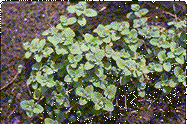 This herb does the opposite to people as it does
to cats. Mixed with chamomile it will enable a sufferer of D.T.s to get some sleep.
Mixed with peppermint it is a pleasant tasting tea to serve to a guest whom you
don’t know very well. This tea will also stop diarrhea -- even tourista! It is
a handy tea to drink when you are going to a job interview or after a hectic day. It calms
the digestive tract, relieves colic in babies, and takes the edge off anxiety. Babies
often prefer it mixed with cinnamon. This herb does the opposite to people as it does
to cats. Mixed with chamomile it will enable a sufferer of D.T.s to get some sleep.
Mixed with peppermint it is a pleasant tasting tea to serve to a guest whom you
don’t know very well. This tea will also stop diarrhea -- even tourista! It is
a handy tea to drink when you are going to a job interview or after a hectic day. It calms
the digestive tract, relieves colic in babies, and takes the edge off anxiety. Babies
often prefer it mixed with cinnamon.
[Menu] [Index]
Cinnamon
This herb promotes digestion. Children often like to chew a stick of cinnamon when they
have upset stomachs. Cinnamon cookies are good to end a meal.
[Menu] [Index]
Addenda:
The following herbs also help digestion: anise, chamomile, caraway, carrot, cayenne,
comfrey, coriander, cubeb berries, dandelion, dill, fennel, garlic, hops, hyssop, parsley,
peppermint, rosemary (which also makes a good hair rinse and helps promote hair growth
after radiation treatment -- mix with sage for best results), sage, marjoram, and rhubarb.
[Menu] [Index]
More Information
95% of all diseases go away by themselves. In most cases, when you use herbs, you are
only speeding that recovery. Most herbs work more slowly than prescribed medicines. So if
you are in pain or have an emergency, you don’t have time to play with herbs. Herbs
are pleasant and inexpensive and fun to play with when you have time. If your dis-ease is
not an emergency, or if it is not responding to standard medical treatment, or if you just
want to help other medical treatments along, the above is enough to help you get started.
Please -- don’t use the above as a replacement for regular medical care. I don’t
want you to be sick!
Best, Lois
[Menu] [Index]
Index
[Aloe Vera] [Blue Cohosh] [Burdock]
[Catnip] [Chamomile] [Cinnamon]
[Cohosh, Blue] [Comfrey] [Cubeb
Berries] [Dock, Yellow] [Elm, Slippery] [Eyebright] [False Unicorn Root] [Fenugreek] [Garlic] [Golden
Seal] [Helonius root] [Hyssop] [Jersey Tea] [Lemon] [Lobelia]
[Nettles] [Onion] [Peppermint]
[Raspberry Leaves] [Red Root] [Shepard’s Purse] [Slippery Elm Bark] [Yellow Dock] [Yogurt]
|